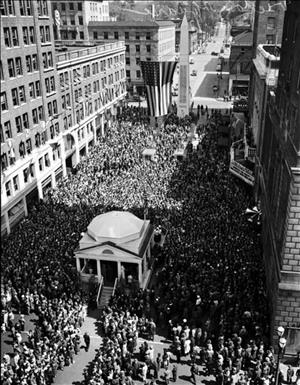On May 2, 1942, dedication ceremonies are held at Victory Square, a civic focal point for Seattle's World War II homefront. Located on University Street, between 4th and 5th avenues in front of the Olympic Hotel, Victory Square is home to rallies, bond drives, and a monument that lists the names of Washington state citizens who lost their lives during the war.
If You Build It, They Will Buy Bonds
Victory Square arose through the efforts of local businessmen, who felt the city needed a centerpoint to raise money and morale for the war effort. Russell W. Young, a newspaper executive, headed the operation committee, George Weber, of the Seattle Advertising Club, coordinated activities for the King County War Savings Committee, Stanley W. Donogh headed the sale of war bonds, and Dietrich Schmitz chaired the county war-savings bond committee. Local theater and musician unions helped with entertainment at events.
A speaker's stand, in the shape of Thomas Jefferson's home, Monticello, was constructed at the west end of the block, and a 75-foot-high replica of the Washington Monument was built at the east end. The monument was inscribed with a growing list of King County war dead, continually updated as the war progressed.
Buy Early, and Buy Often
On dedication day, throngs of people filled the square. An army band played patriotic music, and sailors waved their hats to the crowds. Operatic tenor John Charles Thomas, in town for a concert, led off the festivities with a heartfelt rendition of the national anthem. Then came the push to buy bonds.
Corporal Phillip Horan of the local Transport Guard was one of the first to approach the bond booth, slapping down $100 of his hard-earned money. This bought him bonds worth $125 at maturity, which was just fine by him. Others soon joined the queue, and continued to do so throughout the war.
The Famous and The Dead
Throughout the war, Victory Square was visited by Hollywood's most famous stars who went from city to city nationwide to stir up support for the war effort. Bob Hope spoke at Victory Square several times, as did Bing Crosby. Silver Screen heartthrobs like Betty Grable and Lana Turner wooed the boys with offers of kisses to the men who bought the most bonds. The speaker's stage was also used for free concerts by well-known big bands.
Although movie stars and bandleaders provided much levity and entertainment for the crowds, the monument was a somber reminder of the losses incurred. As the war dragged on, the list of names grew. By the end of the war in 1945, the monument was covered in names.
Gone But Not Forgotten
After the war, the speaker's stage was torn down, but the monument remained until 1949, at which point it was demolished and hauled away. Today (2000), a complete list of all Washington state's war dead is inscribed in a permanent veteran's memorial garden at Benaroya Hall, and also on this website.

